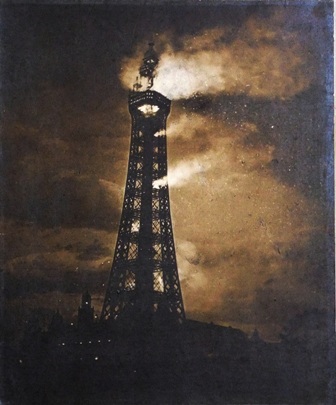Liverpool Mercury, Saturday,
24th July, 1897
BLACKPOOL TOWER FIRE.
LATER
PARTICULARS.
THE STRUCTURE
SAFE.
Further details are now to hand of the alarming fire which broke out on the Eiffel Tower, Blackpool, late on Thursday night. It was very soon
apparent that nothing could be done to save the arrival platform being burnt
out, as a strong westerly wind was blowing, and it was absolutely impossible
for the fire brigade, who were promptly in attendance, under Superintendent Sharrock, to bring
their appliances to bear on the
fire.
Indeed, the brigade confined their attention entirely to
preventing the spread of the flames to the surrounding property, and in this they
were quite successful. Commencing on the west side of the structure, the
fire spread rapidly eastward, and in a marvellously short
space oftime the arrival platform and
two landings immediately above were
enveloped in flames.
 Showers of sparks
flew around in all directions, and large pieces of blazing wood dropped away
from the burning mass, and sped through the air like rockets. As the flames
got better hold of the woodwork, the heat became more and more intense, and
long before midnight the iron framework on the east side of the platform was
white heat. It was at first feared that some of the men were on the platform, and as escape
was obviously impossible from this point anxious inquiries were heard on all
hands as to their safety. Showers of sparks
flew around in all directions, and large pieces of blazing wood dropped away
from the burning mass, and sped through the air like rockets. As the flames
got better hold of the woodwork, the heat became more and more intense, and
long before midnight the iron framework on the east side of the platform was
white heat. It was at first feared that some of the men were on the platform, and as escape
was obviously impossible from this point anxious inquiries were heard on all
hands as to their safety.
Fortunately there were no grounds for apprehension on this score,
all the workmen who had climbed the Tower on the alarm being raised escaping without injury,
with the exception of Mr. Walmsley, whose handswere badly burnt, and who narrowly escaped losing his life.
It was some three hours later before the fames entirely died out, and all
danger of their extension was at an end. By this time all the wooden
erections and framework on the arrival and two higher platforms were totally
destroyed, whilstthe two uppermost
landings, including the crow's nest, were, comparatively speaking,
unaffected.
One
of the most alarming incidents of the catastrophe was the falling of an immense
iron weight counter balancing one of the
cars connected with the hydraulic lift. About
half-past eleven a terrific crash was heard, practically awakening the whole town,
and the residents and visitors poured out of their houses in hundreds and thousands
until the streets in the neighbourhood became almost as thronged as though
itwere midday.
It
appears that the fire had burnt through strands of wire rope attached to the
car and weight, with the result that the latter, weighing eleven tons, fell
from the level of the arrival platforms to the basement of the tower, burying itself in the foundations close to the foot
of the north-east leg. At its fall it
smashed a considerable portion of the iron framework, and plunged through two
concrete floors into one of the private boxes in the circus, and so down to
the ground.
The
effect of the commotion created by this event was terrifying in the extreme, and a
general opinion seemed to prevail among the vast crowd surrounding the
tower that the whole structure was about to collapse. There
was consequently a rapid clearance from the immediate vicinity, and a scene
of almost indescribable confusion followed.
By
midnight the blaze was at its height, and the spectacle as seen for many miles
around was one of awful grandeur. Shortly afterwards, however, the blaze showed
signs of abatement, and it became evident that all inflammable material was nearly
burnt out.
The
trains arrived yesterday with extraordinary loads of passengers, but there was
great disappointment at finding the
tower apparently unchanged. Bills have been placed on buildings saying that the structure is perfectly
safe, and the entertainments will go on as usual. The structure of the
tower itself is practically uninjured, not even the paint
having been scorched below the point where the fire originated on the 380 feet landing.
|